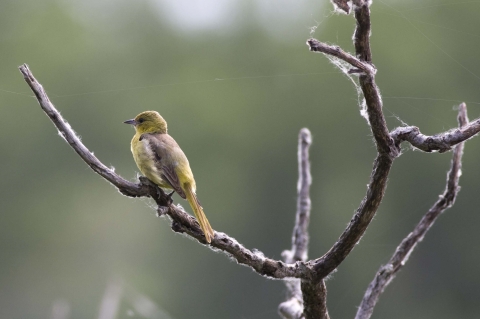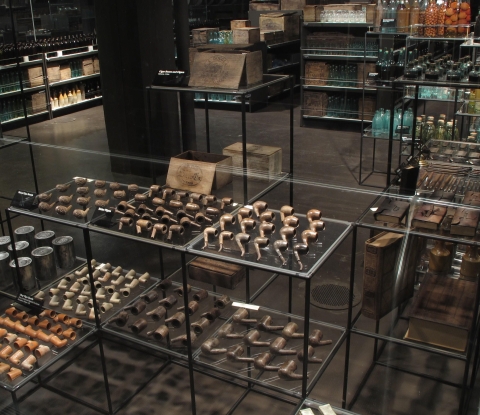About Us
DeSoto National Wildlife Refuge was established in March of 1958 with the approval of the Migratory Bird Conservation Commission with the dual intention of providing for the needs of migratory birds and providing public recreation to local communities. Today the physical footprint of the refuge spans 8,365 acres. DeSoto National Wildlife Refuge is located in the migratory bird corridor of the Missouri River floodplain and provides essential habitat for resident, migratory and endangered species. High quality floodplain forest, grassland, wetland, sandbar and riverine habitats support diverse and productive populations of migratory waterfowl, shorebirds and neotropical birds, as well as rare, threatened and endangered species including the pallid sturgeon, piping plover and least tern. The refuge is a destination for people who want to explore the habitats and wildlife of this part of the Missouri River and get a glimpse of what pre-settlement Iowa and Nebraska may have looked like.
DeSoto National Wildlife Refuge is also home to a premier archeological collection of almost 250,000 artifacts excavated from the buried wreck of the Steamboat Bertrand. On April 1, 1865, the sternwheeler hit a submerged log, 30 miles north of Omaha, Nebraska. Bound for the newly discovered goldfields of Montana from St. Louis, Missouri, the Bertrand sank into the depths of the Missouri River; and after initial salvage efforts, her cargo was written off as complete loss.
Using historical documents, modern treasurer hunters, Sam Corbino and Jesse Pursell located the wreck on DeSoto National Wildlife Refuge in 1968. As the boat was on federal property, the salvors agreed under the requirements of the American Antiquities Preservation Act of 1906, to turn over all recovered artifacts to the U.S. Fish and Wildlife Service for permanent exhibition and preservation in a public museum. By 1969, the vessel's cargo was completely excavated from its thirty feet deep mud tomb. Unfortunately for the salvors, the treasure they sought had eluded them. Insurance company divers had apparently removed most of the mercury and other valuables soon after the ship sank. However, what had been left was a diversity of tools, clothing and food items. The Bertrand's cargo was remarkably well preserved and the collection found in the DeSoto National Wildlife Refuge Visitor Center is a unique time capsule for researchers and visitors interested in America's 19th century material culture.
Our Mission
The mission of the National Wildlife Refuge System is to administer a national network of lands and waters for the conservation, management and, where appropriate, restoration of the fish, wildlife and plant resources and their habitats within the United States for the benefit of present and future generations of Americans.
Our Purpose
Every national wildlife refuge national wildlife refuge
A national wildlife refuge is typically a contiguous area of land and water managed by the U.S. Fish and Wildlife Service for the conservation and, where appropriate, restoration of fish, wildlife and plant resources and their habitats for the benefit of present and future generations of Americans.
Learn more about national wildlife refuge was created for a special purpose. Some were created to protect migratory birds, others to protect threatened or endangered species or unique habitats, while others fulfill another special purpose. All activities allowed on refuges must be evaluated to make sure each activity will not conflict with the reason the refuge was founded.
DeSoto National Wildlife Refuge’s primary purpose is to serve as an inviolate sanctuary for migratory birds. The Migratory Bird Hunting and Conservation Act uses money from Duck Stamp sales to purchase refuge lands. Many lands purchased with Duck Stamp funds were defined as inviolate sanctuaries. These lands, under most circumstances, must be at least partially closed to migratory bird hunting to allow birds a place of refuge and protection where they cannot be harmed.
Our History
March 1958 - DeSoto National Wildlife Refuge was established with the approval of the Migratory Bird Conservation Commission with the dual intention of providing for the needs of migratory birds and providing public recreation to local communities.
October 1960 - The U.S. Army Corps of Engineers completes the DeSoto Bend Cut-off Project, forming the current DeSoto Lake and straightening out the Missouri River to its current path.
November 2, 1968 - Local Omaha treasure seekers Sam Corbino and Jesse Pursell locate the wreck of the Steamboat Bertrand on DeSoto National Wildlife Refuge and begin excavation later that year. Full excavation of the wreck and all its cargo is completed in 1969.
July 11, 1981 - Dedication and grand opening of the DeSoto Visitor Center and Bertrand Museum.
Other Facilities in this Complex
Boyer Chute National Wildlife Refuge is another refuge managed by the staff of DeSoto National Wildlife Refuge and is located about one mile south on the Missouri River near Fort Calhoun, Nebraska. At Boyer Chute National Wildlife Refuge, the namesake side channel was restored after being blocked in 1937 to aid riverboat navigation. Following restoration, many of the wildlife species that historically utilized the land began to return and flourish in the area. On Boyer Chute National Wildlife Refuge, visitors enjoy hiking and birding along the nearly nine miles of hiking trails, hunting of white-tailed deer and turkey in the bottomland forests and fishing along the restored chute.





